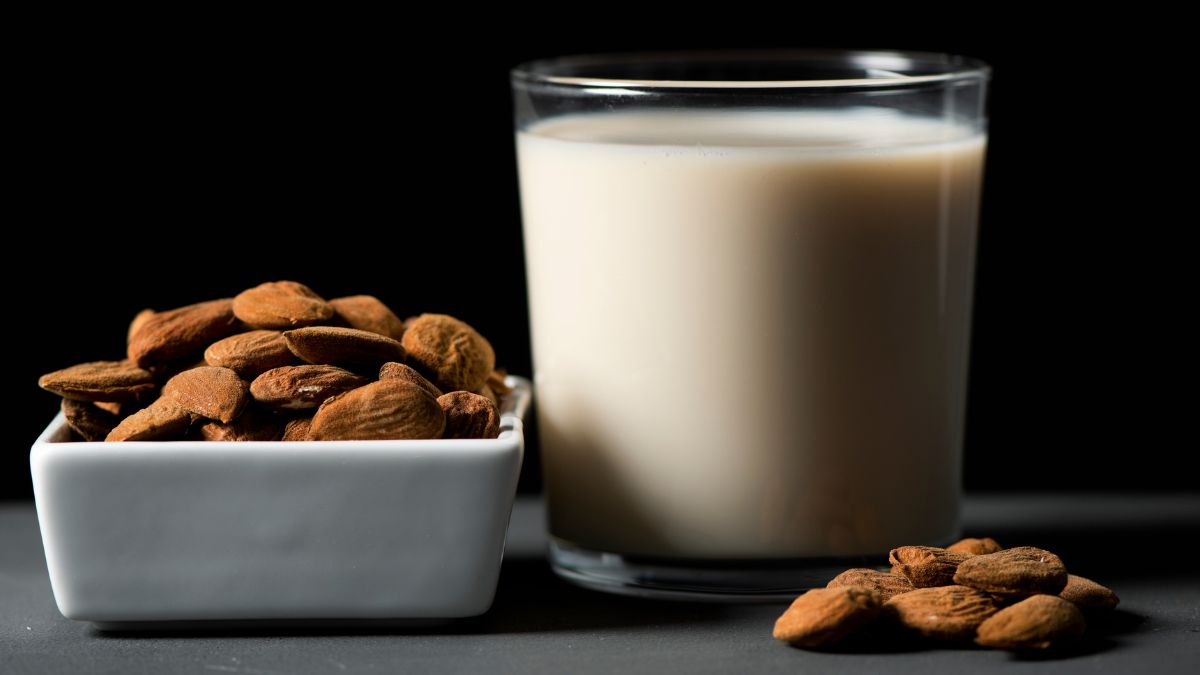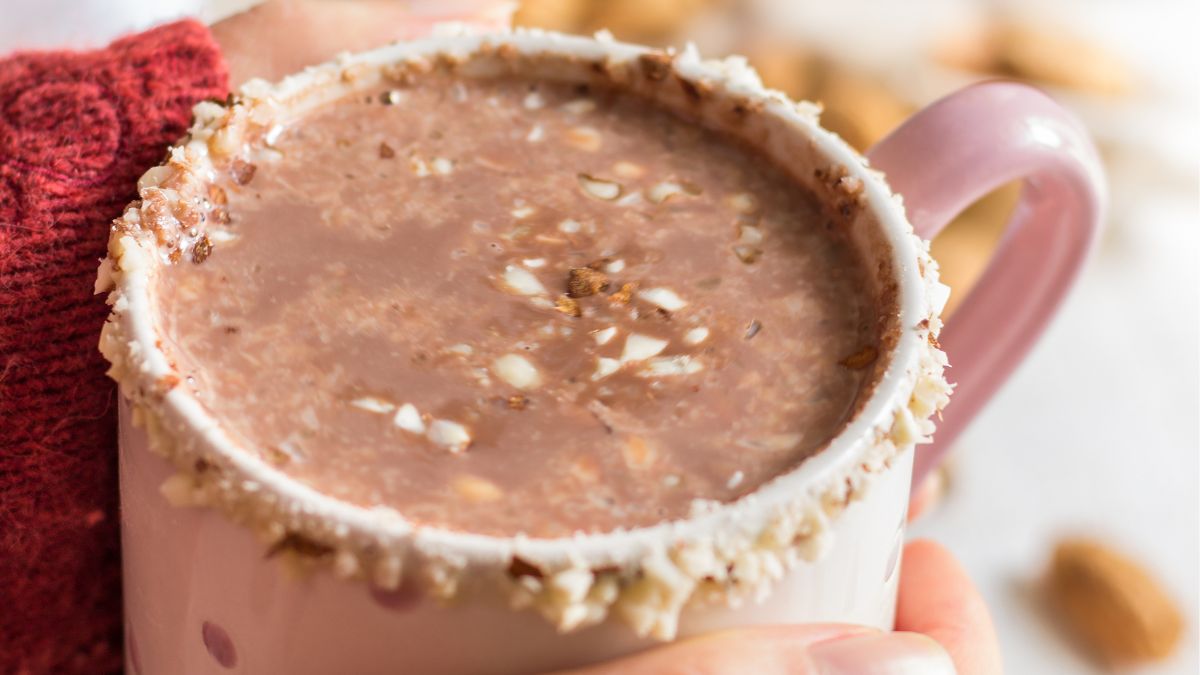Here’s How to Warm Up Almond Milk! [4 Methods Explained]

Almond milk is one of my favorite lactose-free plant-based milk types. Whether you’re a vegan, lactose intolerant, or just want to keep an eye on fat intake – this is a fine choice. It has a particular taste – nutty and light with a fresh aftertaste. Besides it being super tasty, it’s unbelievably simple to make at home. You must’ve read or heard at least once that you can’t warm plant-based milk at all, but this can’t be further from the truth. This article breaks down the crucial question: “Can you warm up almond milk?”
You can warm up almond milk the same way as regular milk using the stove, microwave, double broiler, or hot water. However, the trick is to do it slowly and at low temperatures without boiling it. Yes, it tends to curdle and divide, but you don’t need to give up the signature nutty taste for it.
I love the taste of regular milk, but hate the heavy, buttery feeling I get from it, and almond milk is my ultimate substitute to avoid it! Also, it gives a subtle almondy note to my drinks and baked goods, but still, I must admit – it can be tricky to warm up. Here is a whole list of tips to help you fall in love with this tasty beverage!
How to Warm Up Almond Milk?
You can warm up almond milk in numerous ways, but the key is to heat it at a low temperature. It is prone to burn, so just be careful, and you’ll be good. Here’s a few ways to make your favorite plant-based drik warm and cozy!
On the Stove

If you opt for heating almond milk on the stove, choose pots with thick bottoms. Pots with thinner bottoms will warm fast and are harder to control. Still, even with a pot with thicker bottom, you need to keep the temperature on the low.
Pour cold milk into the saucepan and set it on the stove. Don’t forget to stir it now and then, every 30 seconds approximately. This is important to prevent the milk from sticking to the bottom and to warm it evenly.
It burns easily, so keep an eye on the pot, and remove it from the stove as soon as you see the light steam. Just for heads up, bring your stove to medium heat, never high. It is important to keep all this in mind because burnt almond milk is bitter, and the taste is so far from what you expect it to be.
In the Double Boiler
A double boiler method is the best one to warm up almond milk. It is almost impossible for milk to burn and change its flavor when heated like this. If you don’t have a double boiler pot, just place a bowl on top of a regular saucepan, and move on to the next step.
Almond milk warmed by the steam will save its nutritional value, taste, and aroma maximally. This is a gentle technique, so you don’t need to stir it all the time. If you can choose a warm-up method, choose this way without a doubt.
In the Microwave
Microwaving is probably the fastest option of all. Just pour your milk into a microwaveable cup and toss it in. But keep in mind to lower the power of your microwave, though. What’s more, it’s good to cover the dish with a lid because the milk heats unevenly.
It tends to create hot spots, so stir it before consuming. Also, heat it in intervals of 15 seconds, 4 times tops (1 minute altogether). That way you won’t overheat the milk and you’ll preserve its taste and consistency.
With Boiling Water
If you want lukewarm milk as a late-night snack, this is also a handy option. It’s also quite simple. All you need to do is get a cup and a larger bowl and put one into the other — then pour the almond milk into the cup and the boiling water into the larger container.
Leave the cup in the bowl for a few minutes for the heat to get to your milk. Since your milk is not in direct contact with heat, you’ll get a nicely heated cup of joy with zero chance of it getting burnt or changing its flavor.
Can You Boil Almond Milk?
Technically, yes, you can boil almond milk, though it’s not something anyone would recommend. Here’s why: boiling almond milk will mess up its taste and it could coagulate, separate into layers, and scorch. This happens because high temperatures fractionate protein structures.
So, you’ll end up with a bitter and sour taste, plus a musty smell. Also, it can have a thicker and clumpy consistency, even a change in color. Therefore, don’t ever bring almond milk to a full boil. You can simmer it, though, but very lightly, never rolling boil. The best is to heat it using the methods written above.
There is one more thing to remember before you overheat almond milk — boiling it will mess up its nutritional properties. Since it’s abundant in vitamin E and magnesium, boiling it will reduce the nutritional values. [1] [2] So, it’s definitely better to skip boiling this delicate beverage and keep all of its benefits.
Can You Reheat Almond Milk Twice?
Almond milk is an ultra-fine drink, so it follows that even gentle ways of heating can cause slight changes in its taste. Those petite changes will be more prominent every time you reheat it, especially if you simmer it. To conclude, you definitely can’t reheat it twice if you want to keep the signature nutty flavor and fresh aftertaste.
There is always a but, though. So, if you use gentle methods of heating, like the one with boiling water, you can reheat it twice, no doubt.
Is Almond Milk Supposed to Be Warmed Up?
Like any other milk, you can warm up almond milk with no worries at all. Yes, there are a few things to keep in mind, but overall, you can undoubtedly enjoy a cup of warm almond milk before bed. Whether you’re using store-bought or homemade milk, they are both very tasty when warm.
It will have a light aftertaste of toasted almonds which is super delicious alone or in pair with some other ingredient. So, if you like a warm cup of almond milk, by no means, feel free to warm it up!
Does Almond Milk Curdle when Heated and Why?
Yes, almond milk tends to curdle when recklessly heated. Let’s break down everything: why, when, and how to prevent curdling! The first step to avoid curdling is choosing high-quality almond milk with higher concentrations of almonds.
To include some scientific facts, proteins in almond milk are easier to divide because there are actually fewer proteins in it than in regular milk – just 1 gram of protein per 1 cup of milk. [3] This means it is not particularly stable as it’s mostly water and a few proteins here and there.
Also, another key thing to have in mind is that plant-based milk doesn’t have any cholesterol and it’s lactose-free. Those components are very important in stabilizing and connecting the product, so the lack of them is very much noticeable. That’s why almond milk is delicate and it’s likely to separate and clot.
There are two cases when almond milk will surely curdle: boiling and pouring it into hot liquid. But, the solution always exists – heat it slowly, and then add it warm into the other hot liquid. The main hack is to handle it gently and you’ll be ok.
Besides heating, there is one more thing that affects curdling – acidity. When mixed with highly acidic ingredients like citruses, vinegar, Parmigiano cheese, and many more, it will coagulate. There are two more exceptionally acidic ingredients that are mixed with almond milk frequently – coffee and cocoa. Read on for some tips and tricks to avoid it!
Is Almond Milk Good for Cooking?
Almond milk is a superb substitute for regular milk in almost any recipe. You can actually substitute it with a 1:1 ratio, and you probably won’t even notice the difference unless you have a very sensitive palate. Just be careful to choose unsweetened almond milk if you want to use it for savory dishes!
Plus, consider that almond milk has little to no fats, whatsoever, so your dishes may not be as rich as you want them to be. But, you can always add an egg or two to compensate for it.
If you’re worried about it curdling, there are actually almond milk varieties designed for higher temperatures of cooking and baking. They contain added stabilizers and thickeners, so following that they have a much denser consistency than regular almond milk. The texture is close to heavy cream, though, so it’s not intended for drinking.
The said options are superb if you need warm milk to make a sauce, soup, pudding, cake, or anything else actually. Hence, such almond milk varieties are way richer, creamy, and silky, so you should only use it in meals that call for this kind of consistency.
When making some creamy desserts, sauces, or soups, you can use the richer version of almond milk, but keep in mind that it has a more prominent nutty and sweet flavor. It will actually blend fantastically in the bread mixtures, slightly sweet sauces like Thai, ice creams, smoothies, or mousses.
Can You Heat Almond Milk for Hot Chocolate?

If Martha Stewart says so, then you can! As always, the crucial thing is to do it gently. Just bring almond milk to the boiling point, reduce the temperature, and simmer it till you’re satisfied with its consistency. Of course, tasty hot choco requires fine-quality cocoa which is pretty acidic to start with.
So, to prevent curdling, simmer cocoa briefly along with mixing the blend vigorously till foamy. You can add anything you would add to regular milk – chocolate, cinnamon, sugar, honey, maple syrup, and even hot chocolate mix… The secret is in technique, not ingredients!
Can You Heat Almond Milk for Oatmeal?
Unquestionably, almond-milk-based oatmeal is one of the tastiest recipes for oats there is. Again, just simmer all the ingredients you added to the milk lightly until it reaches a creamy and silky texture. It gives a slightly nutty relish which is a phenomenal base for adding more flavors to get rich and thick oats.
To enhance the subtle almondy taste, add some cinnamon, salt, honey, or any other natural syrup. By heating, almond milk will become extra smooth and velvety because of the almond oil contained in it, that’s the reason for its similarity to cow milk.
Can You Heat Up Almond Milk for Coffee?
Not only can you heat it, but it’s preferable! If you add it blindly, it will probably split, but here’s a trick on how to avoid it. Coffee is a very acidic ingredient, so if you’re pouring almond milk into strong coffee, it will most likely curdle.
If you don’t want to change your habits, there is almond milk intended for coffee only with stabilizers added to it. A frosty layer is inevitable for Starbucks-like coffee at home, as well, but it’s tricky to get it with milk that’s mostly water. Here, opt for almond milk that has a higher concentration of almonds, though.
You will get both with a store-bought barista-labeled almond milk. For those who still want to use regular almond milk, heat it to balance the temperatures out and add one shot of coffee. Follow the heating tips written above and always stick to the same rule – do it gently and slowly!
